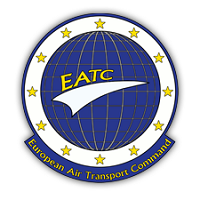This June, the European Defence Agency is helping organize EATT12, the first multinational fixed wing training exercise. Incorporating air transport assets from six nations, this exercise is just part of a wider movement towards cooperation in air transport. We spoke with Colonel Franck Verdierre who is the Head of Training & Exercises Branch at the European Air Transport Command in Eindhoven. EATC have played a vital role in the organization of this exercise.
So there is a major training exercise coming up in June. Please tell us a little about EATT12. What is it, and who is going to be involved?
EATT’12 (European Air Transport Training 2012) will take place on Zaragoza Airbase, from Monday 4th to Friday 15th of June 2012. It is a Multinational Air Transport block training set up in order to gather enough lessons identified and knowledge to pave the way to European Advanced Airlift Tactics Training Course (EAATTC) as from year 2014. EAATTC’s overall objective is to increase tactical awareness and interoperability between EU airlift operators, within the framework of the EATF partnership.
6 nations are participating in EATT 2012: the 4 EATC nations (France, Germany, Belgium and The Netherlands), the Czech Republic and Spain. The EATT detachment will be made up of around 200 persons. Each national contingent will be composed of at least 1 airframe, 2 flying crews, a maintenance team and an INTEL officer. Of course, EATC is also strongly involved in the preparation and the conduct of EATT 2012.
Why is this exercise being conducted? What is the importance of this exercise, and why is it unusual?
The main objective of this block training is to get the participants current in their qualifications in a short time period on their dedicated assets, either by consolidating existing qualifications or regaining them if necessary. The training programme is based on the training requirements defined by nations.
EATT 2012 is also a workshop aiming at enhancing interoperability between tactical airlift (C-130, C-160, Cn-295…) users in the area of operations and training by starting to work out standardised procedures. Lots of exercises have already been conducted to train fighters but such a block training for Air Transport assets is a big first in Europe.
What does EATC do in general, and what has their role been in preparing EATT? How has it been, working with the EDA?
The organization of EATC is built on two pillars: an operational pillar mostly based on the operational control of transferred assets; and a functional one that aims at developing policies and common standards related to Air Transport Employment, Training and Exercises, Fleet Management and Logistic Capabilities, according to the Transfer of Authority granted by each nation. The role of the Functional Division is of high importance to reach higher interoperability between nations and to prepare the entry into service of common fleet such as the A400M and the MRTT.
Some EATC members are deeply involved in several EDA/EATF Ad Hoc Working Groups. They also participated in the latest TAT Symposium that took place in Eindhoven in November 2011. This annual symposium associated with a specific Block Training such as this one in Zaragoza would be in the future the backbone of the EAATTC, just as it currently is in the USA with their AATTC.
Working with the EDA is a very efficient way to develop air transport training in Europe. Both EATC and EDA have a key role. EATC provides expertise on several domains (training, intelligence, maintenance…) whilst EDA has the adequate levers to address national authorities, and convince them to develop cooperation.
What do you hope will be learned from EATT?
In addition to common training objectives, EATT will test a multinational Air Transport Intel cell and a multinational cross-services maintenance. Lessons learned from EATT will be a solid basis for future deployments in the scope of European operations, in the perspective of the use of the A400M and in the set-up of EAATTC.
What are your hopes for the future of air transport training?
Some American observers coming from the US AATTC will participate in EATT12. Some other nations such as Italy, Greece or Sweden have expressed a willingness to participate in EATT13. On top of this initiative, some multinational training courses such as MART (Multinational Aircraft Recovery Training 21-25/05/12, Orléans Airbase) are being developed. I am very optimistic for the future of transport training and the extension to multinational participation. In addition to what is developed across the Atlantic, Europe will then be able to offer complementary training opportunities.
EATT seems to be a great example of European defense cooperation. Do you agree? What is your general view of European defense cooperation?
Yes, EATT is a great example of European defense cooperation. A common Air Transport training in Europe will undeniably have to be developed. As all nations face budget cuts and economic problems, they have to focus their attention on training opportunities that enhance interoperability, optimization and rationalization. The latest declarations about AAR capabilities are a further evidence of this trend and show the increasing interest for European defense cooperation.
This Q&A is part of a series of discussions with the key players in EATT12 and European air transport cooperation. Look out for more in the coming weeks.
